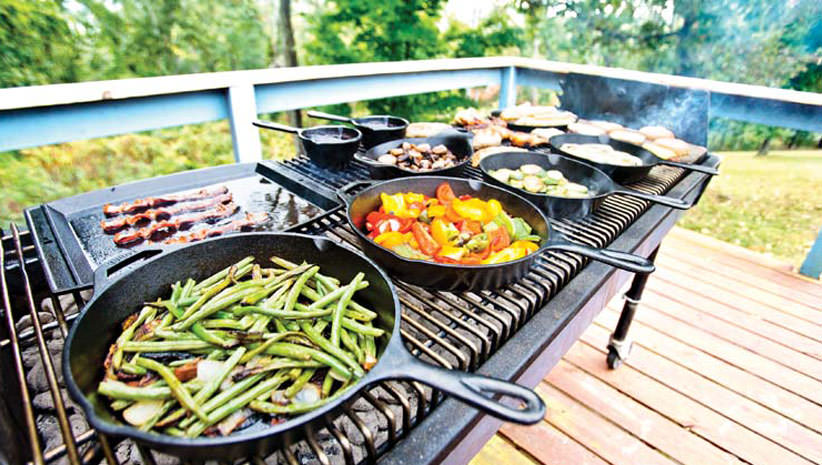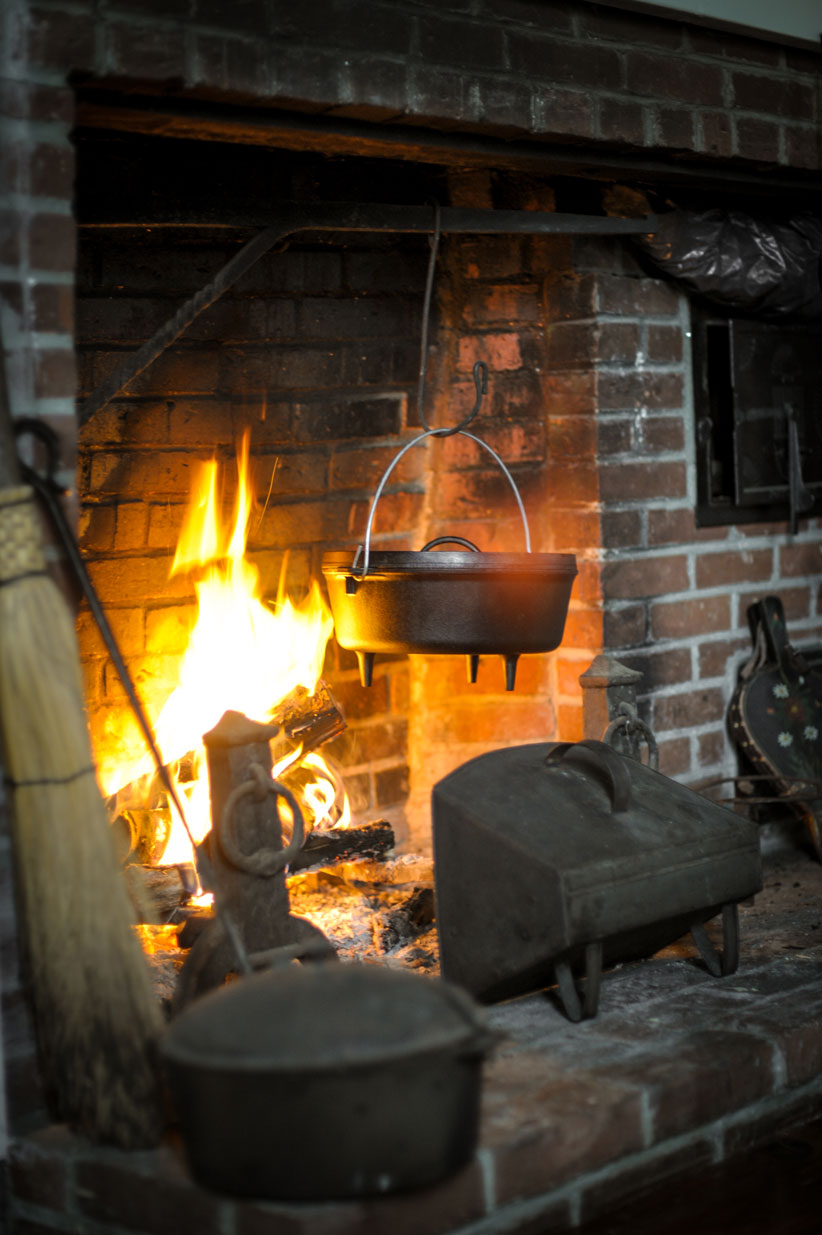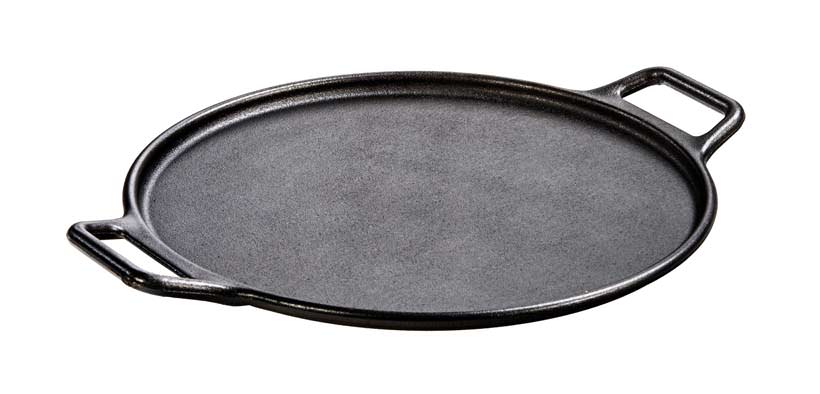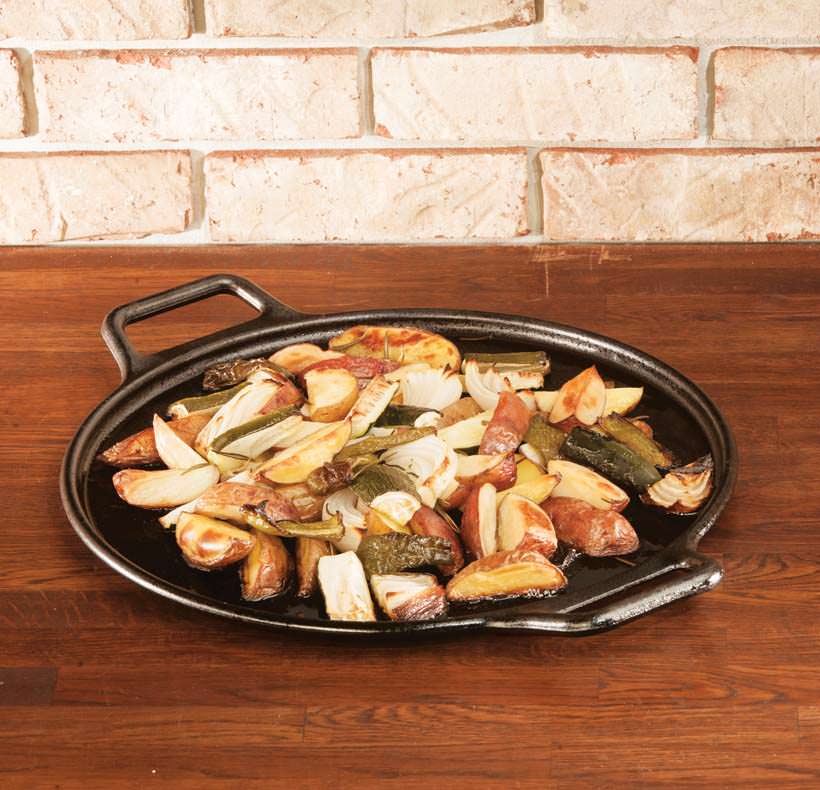
Photo Courtesy of Lodge Manufacturing
The fire crackles as firelight dances on the wall behind me, while snow softly falls outside of our old Maine farmhouse. The faint smell of wood smoke mixes with the aroma of mulled cider, roasting cranberries, and corn chowder slowly cooking over an open fire in a variety of cast iron cookware. I smile at the thought of cooking our dinner in the same fashion as those who built this farm in 1790.
However, cooking with cast iron is not just for those who want to relive the past, it is for health-conscious people who want to use cookery that is un-treated with chemical non-stick surfaces, for gourmet cooks who demand even heat distribution, and for those who want to leave something of themselves to the next generation. Are you intrigued? If so then read on…

Cast Iron in the Fireplace Photo by Susan Currie
Connection To Our Past
Cast iron cookware was the cooking utensil of choice for our forefathers; it was readily available, inexpensive, extremely versatile, and nearly indestructible. Cast iron cookware witnessed the first fledgling British colonies in America, the American Revolution and the westward expansion to the Pacific Ocean. In fact, colonial America thought so highly of this cookware that George Washington’s mother had a specific clause in her will determining who was to inherit her cast iron! Cast iron has a storied history even before its arrival on US soil. The Dutch perfected the art of casting molten metal into molds in the 16th century and by the mid-18th century, reusable molds were developed that allowed for a greater variety and quantity of cookware to be created. The methods used to make cast iron cookware in the colonial era is still very similar to how these products are produced today. The invention of readily available aluminum and stainless steel cookware in the 20th century marked the decline of cast iron cooking until recently when many people are rediscovering the joys of cooking with cast iron.
Advantages of Cooking with Cast Iron
The gourmet cooking resurgence of recent years is perfectly suited to the use of cast iron cookware. Cast iron absorbs and distributes heat evenly across the entire cooking surface, it is versatile enough to fry, sear, bake, saute, and more, all in the same piece of cookery. It can be used over a gas flame or on an electric stovetop, in an oven to bake/broil, or over an open fire. Over time cast iron will develop its own non-stick coating if kept properly seasoned without the use of chemicals. (Commercial coatings on nonstick pans, such as Teflon, may leech into food particularly during high heat applications.) When you pick up a piece of cast iron cookery you will immediately note its heft. With proper care, cast iron cookery should last a lifetime or more. High quality cast iron cookery can be had for a fraction of the cost of today’s high-end cookware whether bought new or found at a local yard sale.
Disadvantages of Cooking with Cast Iron
There is no getting around the fact that cast iron is heavy and may not be manageable for some, especially those with arthritis and other joint problems. Another concern can be with some modern glass top stoves, as cast iron can scratch/damage the surface if not used carefully. Cast iron will easily rust if left wet even overnight and so must be completely dry except when in use. Finally, care must be taken when cleaning cast iron (and is approached somewhat differently than modern cookware), as it is possible to remove the “seasoning” which gives it its non-stick surface.
Antique (aka rusty) Cast Iron
So, your significant other has just come back from a day of yard sale treasure hunting and scored the “deal of a lifetime” on a set of historic (read very rusty) cast iron cookware. What to do? Fear not, as there is hope! As long as the cookware is not cracked, severely warped, or so rusted that you can see through it…antique cast iron can be restored with a little bit of elbow grease. The first order of business is to use sandpaper or steel wool to remove all of the rust. The next step is to wash the cookware with warm, soapy water and then dry completely. Finally, to season your newly restored cast iron you will need to apply a coat of vegetable oil to the entire piece of cookware, turn it upside down and bake in the oven at 350 degrees for about 30-60 mins. Presto! You now have fully functional cookware, a story to tell friends when cooking dinner for them, and an excuse to visit that antiques shop down the road to see if they have any more cast iron cookware or other treasures. For those interested in collecting antique grade cast iron cookery, look for pieces by Griswold, Wagner, or Lodge.

Photo of Cast Iron Skillet Courtesy of Lodge Manufacturing Company.
Buying New Cast Iron
When purchasing new cast iron cookery the most important thing to note is whether or not the piece of cookery has been pre-seasoned or not. A pre-seasoned piece of cookery is ready to use as a layer of oil has been baked on which acts as both a protectant and non-stick surface. If the piece of cookery has not been pre-seasoned, it will need to be seasoned (see instructions above) prior to use. New cast iron cookery ranges in cost depending on the brand, style and size but expect to pay anywhere from $10-30 for smaller pieces to $60-100 or more for large pieces (such as Dutch ovens).
Caring for Cast Iron Cookware
Cleaning cast iron involves a slightly different process than for your other cookware because the seasoning that makes cast iron non-stick can be accidentally washed off. Many professional chefs recommend that you simply rinse your cast iron cookware in water and then wipe out any remaining residue with a soft, non-abrasive cloth or paper towel. Another variation is to wipe out any debris, partially fill the cookware with water and heat on the stove until the water boils for a few minutes, then drain and wipe dry. If you are going to use soap you will need to apply a coat of vegetable oil after you have cleaned, then dry thoroughly as soap will remove the seasoning layer. With a little bit of care you will enjoy your cast iron cookware for many years to come.

Cast Iron Skillet Courtesy of Lodge Manufacturing Company.
Skillet Cranberries Recipe Courtesy of Abigail Adams
This delicious (and simple) recipe is courtesy of Abigail Adams (wife of our second president John Adams) and dates from the 1790s. Take one pound of fresh cranberries and add two cups of sugar (adjust according to preference) and place in a cast iron skillet. If cooking on the hearth (or by an open fire) the recipe calls for a “slack” fire (dying-down fire) for about one hour. If cooking in an oven, bake for 45-60 minutes at 250 degrees. Once cooked (berries should look like they popped and be quite soft), add a 1/4 cup of brandy and enjoy!

Cast Iron Skillet Photo Courtesy of Lodge Manufacturing Company.
Frank Ferrucci is a maple syrup producer, wood turner, hearth cooking enthusiast and co-owner of Maple Moon Farm in Lebanon, Maine (clearly he has a problem sitting still). Frank is originally from Lawrence, Massachusett, but met a country girl and the rest is history. For more info about the farm and staying at the farm please visit: maplemoonfarm.com.
